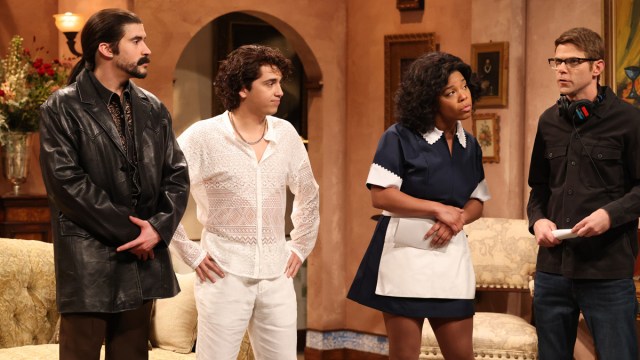The Current State of TV Streaming: Great Stories vs. Instant Virality
Drive business and brand growth with winning media strategies at Mediaweek. Hear from experts at TIME, Peloton, YouTube, Google and more, October 29-30 in New York City. Register.
You’ve found a new show. It feels made for you. It’s well written, the cast is phenomenal, and you can’t wait to see where Season 2 goes. The show’s only been out for about two months, but you see news that it’s been cancelled already. Another bites the dust. You realize something that felt made for you simply didn’t have the appeal or virality to make it worth saving. Another great story was lost to a war of numbers.
The ongoing cycle of show cancellations on streaming platforms is creating an unsettling atmosphere for viewers, eroding trust and weakening the connection these platforms strive to build with their audiences. Shows are often discontinued after a single season or even midseason, stalling the growth of fan communities and leaving audiences questioning the value of investing in new series. Netflix’s Kaos and Amazon’s My Lady Jane were both canceled within months of release, with My Lady Jane competing against the likes of the Summer Olympics coverage during half of that time. Was it ever positioned to be successful?
Quantity over quality
Do these shows need more marketing? The broad mass appeal? Was it crap?
For shows like Kaos and My Lady Jane, critics and audiences agreed they were fantastic, with Kaos receiving 76% and 83% Rotten Tomato critic and audience scores and My Lady Jane receiving 95% and 91% on Rotten Tomatoes, respectively. This isn’t a decision of quality but rather of numbers, and virality, in a short amount of time. While movie releases are seen as flops or successes by whether they cross the billion-dollar mark, it seems streaming has adopted the same myopic view of success. If it doesn’t have blockbuster appeal, it isn’t worth saving and building up an audience.
This fosters a lack of trust in viewers who don’t want to invest their time and energy into a new show when the unlikelihood of closure and future seasons is precarious at best. Because of this growing apprehension among viewers, they now choose to wait until a show is confirmed for additional seasons before they start watching.
This wait-and-see approach diminishes the excitement of discovering fresh narratives, replacing it with a cautious approach focused on avoiding disappointment. This in turn lowers viewer counts and perpetuates the cancellation of future shows. They don’t want to watch it because they don’t want to be disappointed, and streaming services cancel regardless of acclaim and sentiment. It’s a vicious cycle where art goes to die.
Risk aversion leads to monotony
Streaming platforms seem to be in a state of trial and error, heavily relying on quick viral success to decide a show’s fate. This scattergun strategy reveals an industry still grappling to understand what audiences want. By cluttering their catalogs with volume in hopes of finding hits, they tend to overlook high-quality productions for broader, more immediately gratifying content, streamlining their focus toward mass appeal.
This fear of not capturing what works means that we see the same IP and story tropes told over and over again. There is a lot of talk about “superhero fatigue,” but we don’t talk enough about “procedural fatigue,” where the same show with different settings and casts are made over and over again as long as there is a market for them.
Innovation and newness denote risk. It means as streaming service customers we see the same shows and movies over and over again, with little or nothing to watch or engage us. When searching for fantasy or newness we continue to scroll, hoping for something that will pop out with its eccentricity and differentiation. It’s the pop music-ification of visual entertainment. Art is not art, but a commodity that must be popular enough for the masses to endure.
This fixation on instant popularity stifles the potential of niche and unique genres, making it hard for thoughtful, original shows to shine. Reality TV and easily digestible programming often overshadow more complex storytelling, flooding the market with entertainment that values ease over engagement. As a result, quality art is replaced by content that requires minimal thought and effort from its viewers. These programs provide the viewership necessary to be deemed successful, even if those shows are hate-watched.
As Empire writer Ben Travis so profoundly stated, “Streaming services are over-feeding and starving their audiences at the same time.” We are at the entertainment equivalent of having too many clothes and yet nothing to wear, because nothing speaks to us. It’s all a commodified landscape of intellectual beige in the background so you don’t have to turn your brain on while you watch.
The disparity in marketing efforts
Adding another layer to this issue is the obvious disparity in marketing support for different shows. Some series receive widespread promotional efforts, saturating media channels, while others are left in the shadows with minimal attention. This uneven marketing means that some shows get canceled before many potential viewers even heard of them, frustrating audiences who feel they never had a chance to discover new content that might have resonated with them.
This marketing imbalance leads to disappointment, as dedicated viewers often react with surprise or anger upon learning about the cancellation of a show they never even knew existed. The perceived randomness of marketing efforts undercuts the discoverability of shows and amplifies frustrations when only those heavily promoted manage to break through the surface.
The business model here reflects a broader issue where companies announce their intention to build communities but retreat when immediate success isn’t evident. This shortsightedness curtails the formation of fan bases and vibrant communities before they can even get started.
For those trying to keep updated on the current wave of cancellations, resources like Vulture’s list of 2024’s axed shows and Forbes’ report on Netflix’s recent cancellations highlight the uncertainty in the industry. The sudden ending of a promising series such as My Lady Jane further emphasizes the unpredictable nature of streaming decisions.
To break this cycle and rebuild viewer trust, streaming platforms must shift their approach to support diverse and innovative stories more genuinely and stop relying on low-hanging fruit. Viewers deserve more and streamers need to do more than stuff content into platforms while upping the price every time you turn.
https://www.adweek.com/convergent-tv/the-current-state-of-tv-streaming-great-stories-vs-instant-virality/

